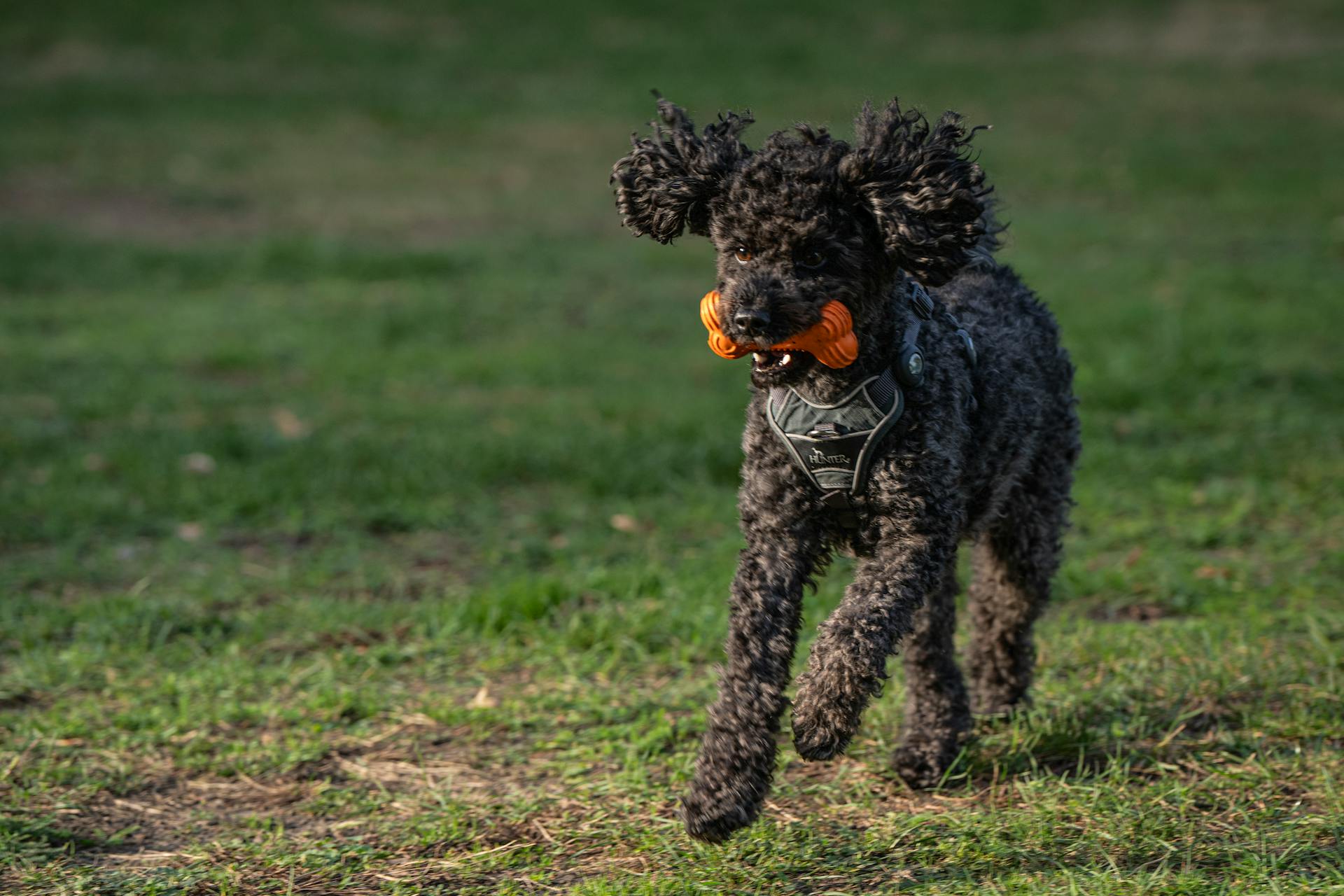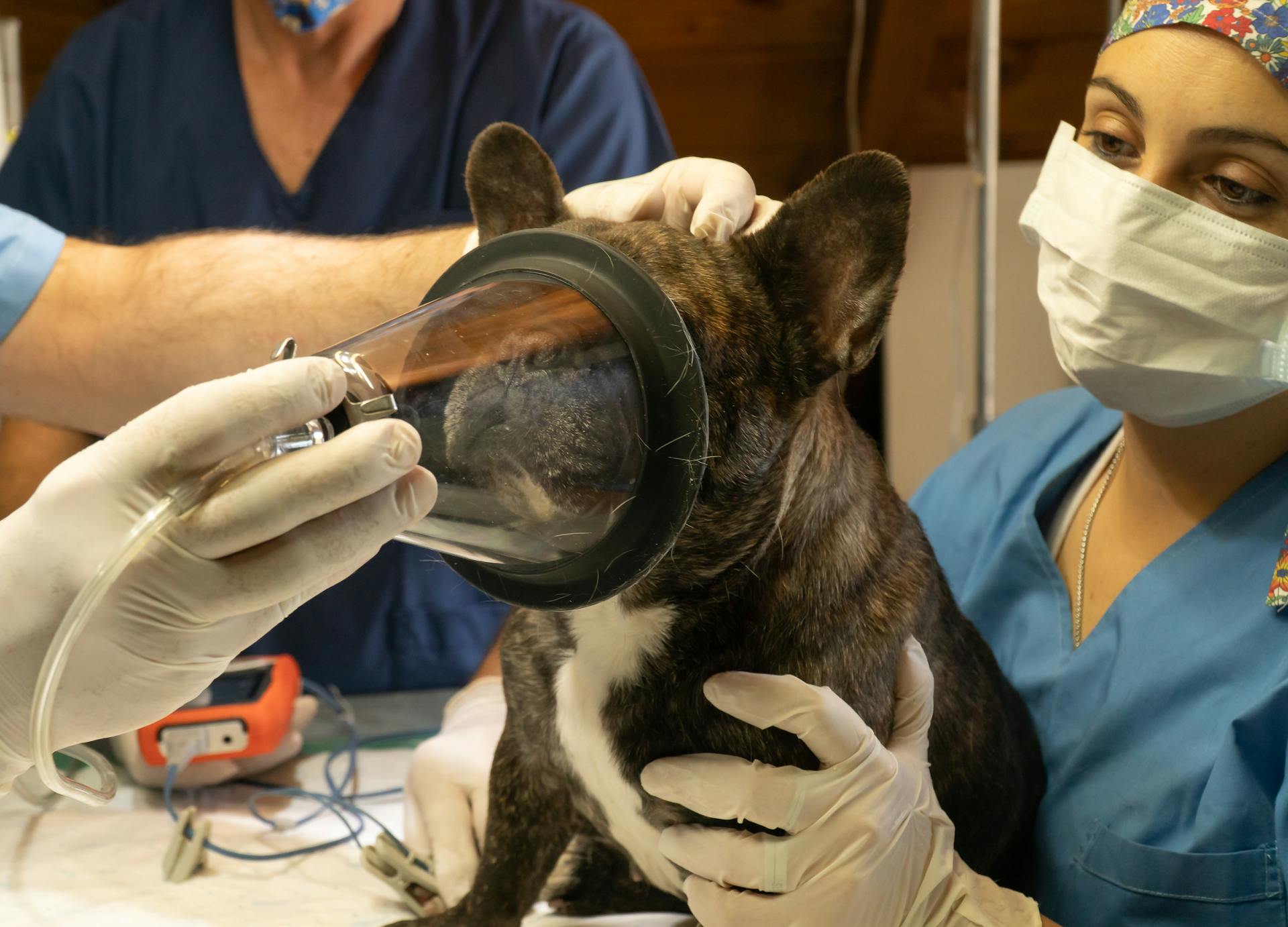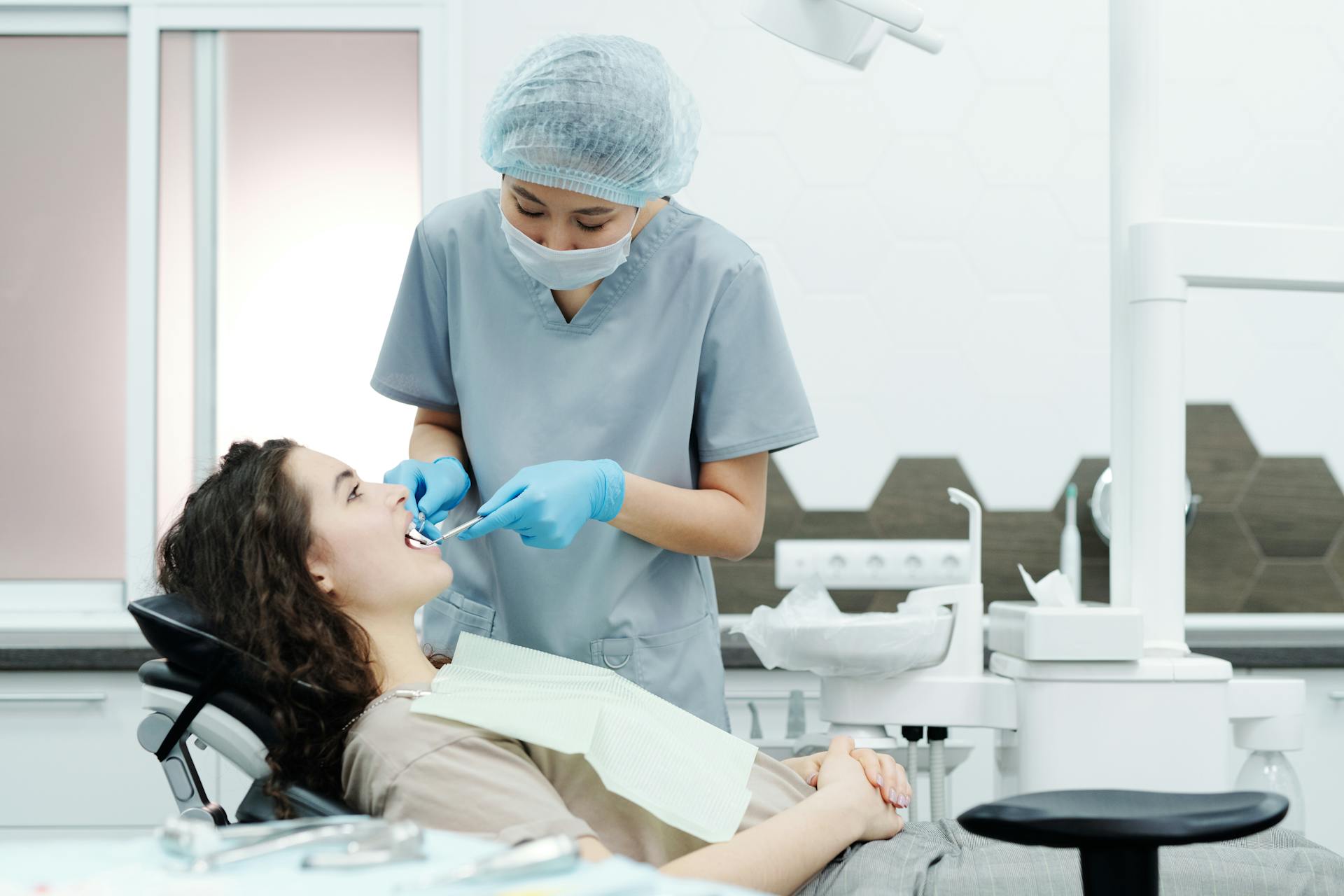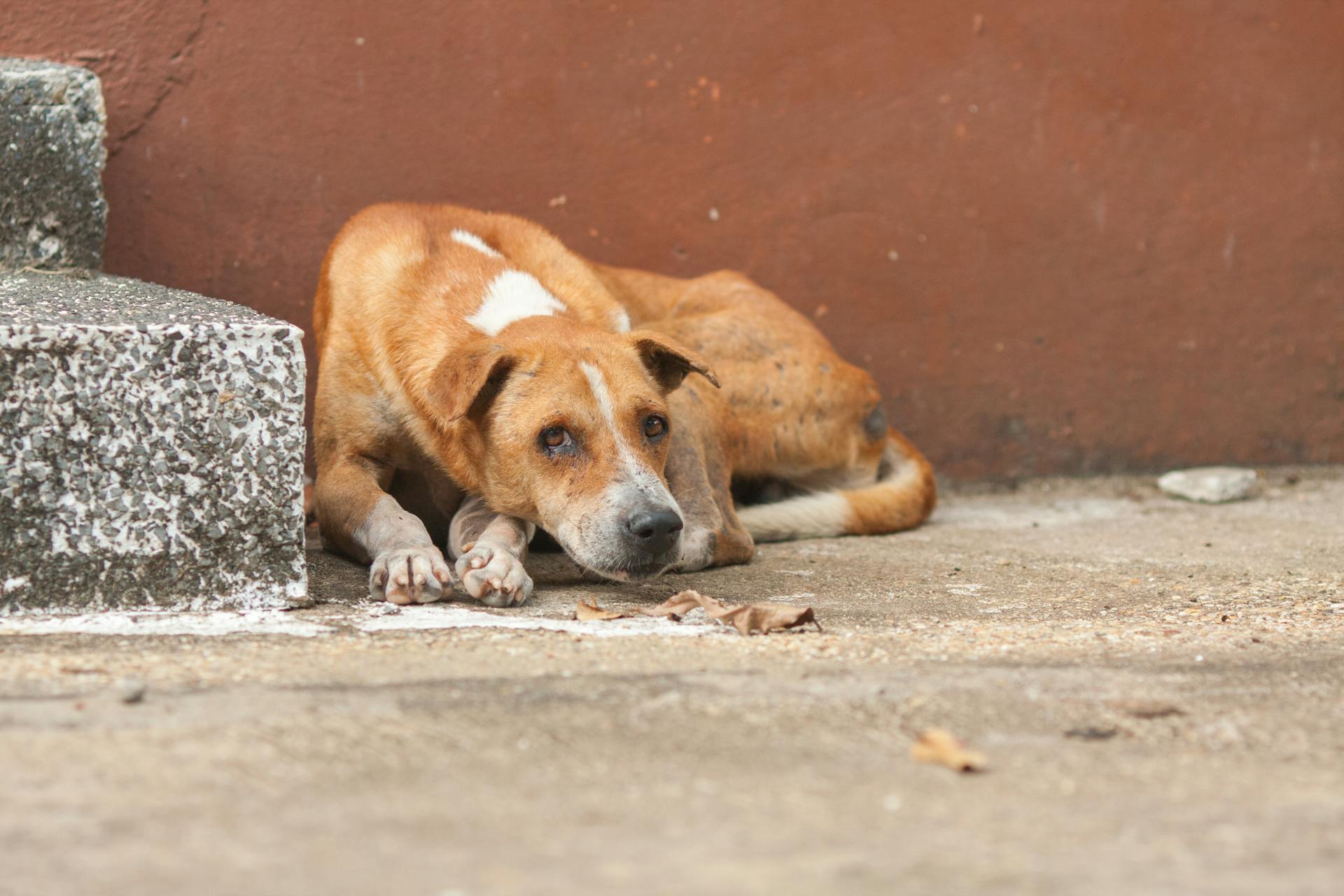
Dog dental diseases are a common health issue that affects many canine companions. According to the article, periodontal disease is the most common dental disease in dogs, affecting over 80% of dogs by the age of three.
Preventing dog dental diseases starts with good oral hygiene. Regular brushing of a dog's teeth is essential to remove plaque and tartar, which can lead to gum disease and tooth loss.
Dogs can't tell us when they're in pain, but signs of dental disease include bad breath, yellow or brown teeth, and bleeding gums. These symptoms can be a sign of more serious issues like periodontal disease or tooth abscesses.
Regular veterinary check-ups can help identify dental problems early on.
What Is Dog Dental Disease?
Dog dental disease, also known as periodontal disease, is the most common dental issue in dogs.
It's caused by the accumulation of dental plaque and tartar on the teeth, which triggers inflammation. This leads to gum infections, bone loss, and if left untreated, the loss of teeth and other serious health problems.
Periodontal disease affects not just the teeth, but also the surrounding structures, including the gums and bone.
The bacteria that accumulate along the gumline, known as plaque, are the real problem behind periodontal disease.
Check this out: Dog Diseases That Cause Hair Loss
Causes and Risk Factors
Poor dental hygiene is a major contributor to oral disease in dogs, as it allows bacteria to accumulate and lead to gingivitis and periodontal disease.
Regular brushing and professional cleanings can prevent the buildup of plaque and tartar on a dog's teeth. However, some dogs are more prone to developing oral disease due to genetic factors, such as breed predispositions or inherited dental issues.
Breed-specific traits, like short muzzle shapes, can increase a dog's risk of dental problems. For example, pugs and bulldogs are more likely to experience dental issues.
Aging is another significant risk factor, as older dogs are more susceptible to oral disease due to years of plaque buildup and wear and tear on their teeth.
Recommended read: Best Food for Dogs with No Teeth
Causes of Oral Issues
Oral disease in dogs can be caused by a combination of factors, including poor dental hygiene and genetics.
Regular brushing and professional cleanings are essential to prevent the buildup of plaque and tartar on a dog's teeth.
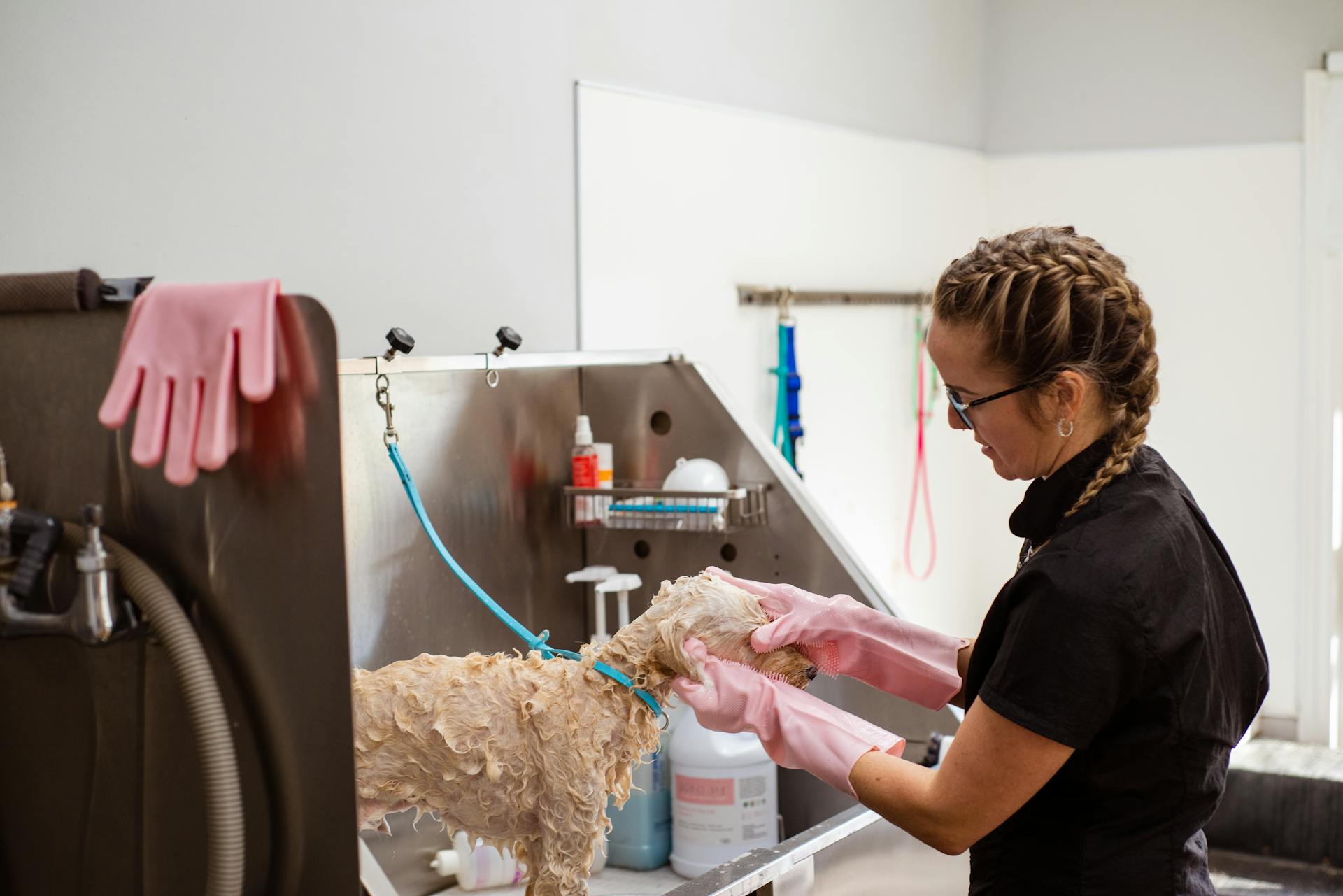
Dogs with short muzzle shapes, such as pugs and bulldogs, are more prone to dental problems due to their breed predispositions.
Older dogs are more susceptible to oral disease due to years of plaque buildup and wear and tear on their teeth.
A poor diet high in carbohydrates and sugar can contribute to the formation of plaque and tartar on a dog's teeth.
Here are some common factors that can contribute to oral issues in dogs:
- Poor dental hygiene
- Genetics (breed predispositions or inherited dental issues)
- Age (years of plaque buildup and wear and tear)
- Diet (high in carbohydrates and sugar)
Smaller breeds are more likely to develop periodontal disease due to their smaller teeth and less bone mass anchoring each tooth.
Tartar begins to appear in a dog's mouth around two to three years old, and if left untreated, can progress to periodontal disease.
Enamel Defects
Enamel Defects can be a serious issue for dogs, especially if left untreated. They can be caused by fevers and the deposition of chemicals within the tooth.
The canine distemper virus is a major culprit, as it attacks the enamel-producing cells of the teeth and causes a fever, resulting in thinner-than-normal tooth enamel.
Other fever-causing diseases can also lead to enamel defects, causing the enamel to develop improperly and become weaker than normal.
Severe malnutrition in young dogs can also cause enamel defects, which can have long-lasting effects on a dog's oral health.
Infections in fractured baby teeth can affect the enamel of the permanent teeth that come in behind them, leading to enamel defects in isolated teeth.
Enamel defects can also be inherited, especially in Siberian Huskies, highlighting the importance of genetic testing and responsible breeding practices.
Signs and Symptoms
Bad breath, or halitosis, is a common sign of dog dental disease. It's not just "dog breath" - if your furry friend has persistent bad breath, it's a sign that something is amiss in their mouth.
Some dogs may have trouble chewing, especially hard food or treats, due to dental problems. This can be a sign that your dog needs to see a vet.
Excessive drooling can be a sign of oral pain or inflammation in your dog's mouth. If you notice your dog drooling more than usual, it's worth investigating further.
Expand your knowledge: Puppys Mouth Bleeding
Bad breath is often the first sign of dental problems in dogs. So, if you notice a persistent stinky smell coming from your dog's mouth, don't ignore it.
Pawing at the mouth or face can indicate oral pain, so if you see your dog doing this, it's a good idea to take them to the vet.
Prevention and Maintenance
Prevention is key when it comes to keeping your dog's teeth and gums healthy. Regular dental checkups and cleanings are a great way to help prevent dental disease and catch problems like periodontal disease early. Your veterinarian will also want to do regular professional cleanings when needed, which require anesthesia and involve removing tartar and plaque, performing dental radiographs, and polishing your dog's teeth.
Brushing your dog's teeth daily with a veterinary toothpaste is a great way to prevent dental disease. If your dog doesn't allow brushing, wiping their teeth with gauze every two or three days can also be effective. Your veterinarian can help you determine the best at-home dental care routine for your dog.
For another approach, see: What to Feed Dogs If Out of Dog Food
Feeding your dog a balanced and healthy diet can also contribute to good oral health. Avoid feeding your dog too many sugary or sticky treats, as these can lead to dental issues. Your veterinarian may recommend specific foods, toys, and treats to help clean plaque off your dog's teeth.
Here are some at-home dental care tips to keep in mind:
- Toothbrushing: Brush your dog's teeth daily with a veterinary toothpaste she can swallow. If your dog doesn't allow brushing, wipe her teeth with gauze every two or three days.
- Dental chews and treats: These can help fight plaque.
- Water additives and rinses: Your veterinarian may recommend this for dental health.
- Teeth-friendly toys: Thin rawhide strips and rubber toys may help strengthen your dog's teeth, while harder toys can cause tooth chipping.
It's also important to note that dogs' dental needs will change throughout their lives. Puppies should start getting used to toothbrushing early, while adult dogs should brush their teeth daily. Senior dogs may need more frequent dental checkups and may require special dental care.
Diagnosis and Treatment
Diagnosing periodontal disease in dogs is crucial to prevent tooth loss and other complications. A quick dental exam should be included in every vet check-up, and if an oral infection is suspected, a complete oral examination is necessary.
Your vet may take dental x-rays and use instruments to measure bone loss. Tartar located above the gumline is noticeable and looks like brown concrete, but it's harder to detect when it's spread under the gumline.
Periodontal disease can be broken down into four stages: gingivitis, early periodontitis, moderate periodontitis, and advanced periodontitis. The stages are defined by the amount of bone and ligament loss, with advanced periodontitis indicating bone loss of 50% or greater.
Here are the four stages of periodontal disease in dogs:
- Stage 1: Slight swelling and redness of the gums (gingivitis)
- Stage 2: Early periodontitis with mild to moderate loss of bone and ligaments
- Stage 3: Moderate periodontitis with up to 50% loss of tooth support
- Stage 4: Advanced periodontitis with 50% or greater bone loss
Tooth Resorption
Tooth resorption is a relatively common and painful condition in cats.
It's not as common in dogs, but it can still occur.
These lesions are often located at the "neck" of the tooth, where the gingiva meets the crown.
Related reading: Most Common Dog Diseases
Diagnosing
Diagnosing periodontal disease in dogs requires regular check-ups and a keen eye for signs of trouble. A quick dental exam should be included in each vet visit.
Tartar buildup is often noticeable above the gumline, looking like brown concrete. However, the real problem arises when plaque and tartar spread under the gumline.
To diagnose periodontal disease, your vet may take dental x-rays and use instruments to measure bone loss. This helps detect damage to the supporting tissues around the tooth.
Take a look at this: Veteran Dog Treats
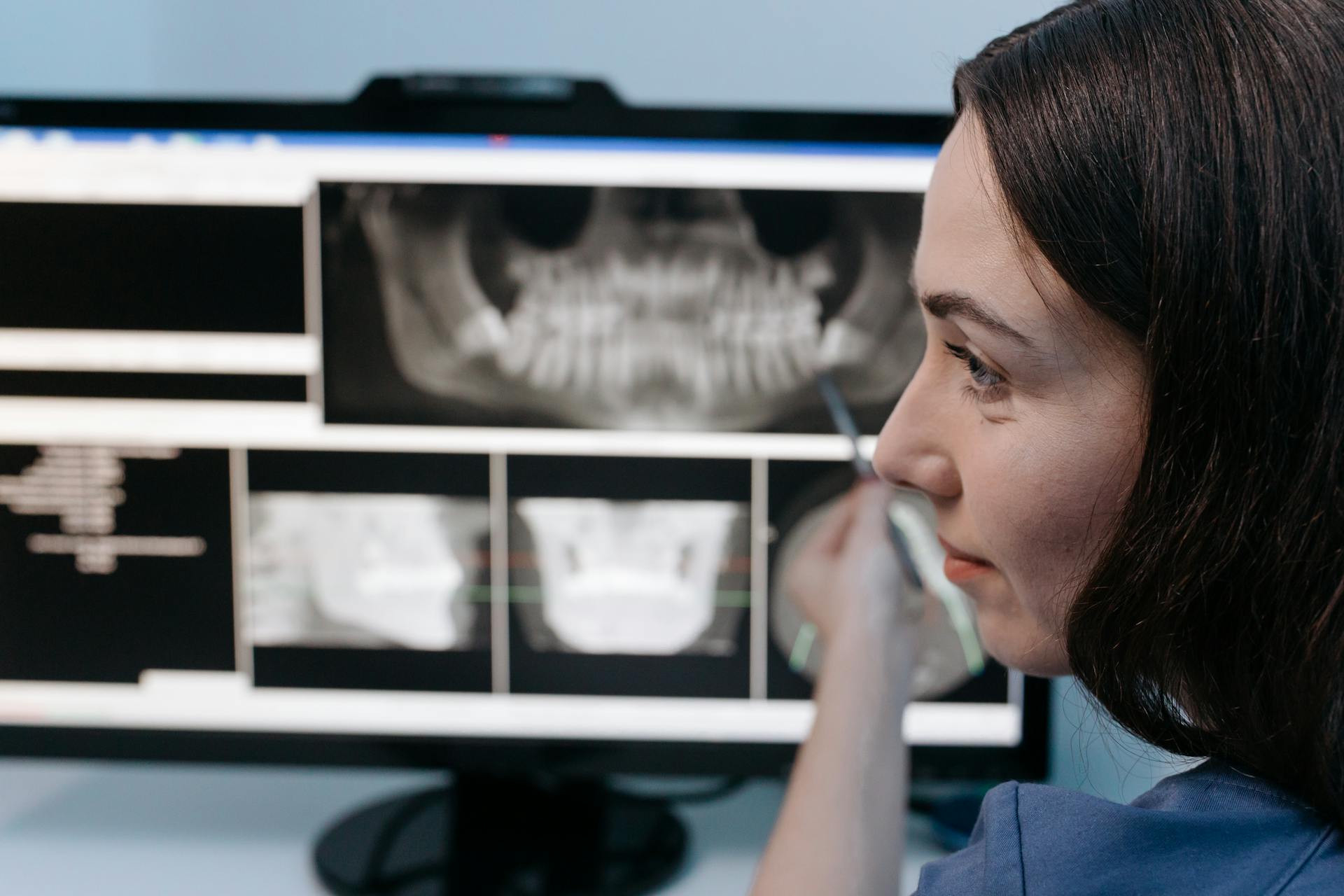
Here are the four stages of periodontal disease:
Treatment
Treatment for periodontal disease in dogs depends on the severity of the condition. Your vet will recommend a treatment plan based on the stage of the disease.
If your dog has stage 1 periodontitis, treatment typically involves a professional dental cleaning and application of fluoride to prevent plaque accumulation.
For stages 2 and 3, a deep scaling or scraping is necessary to remove plaque and tartar buildup, followed by polishing to create a smooth surface that makes it harder for plaque and bacteria to stick to the tooth. This procedure always requires general anesthesia.
In stage 4, surgery is often necessary to treat the affected teeth, which usually means extractions.
Your vet will recommend extraction if the teeth have reached the point where they cannot be saved due to infection, bone loss, or pain.
Tooth extractions can be a significant part of the treatment plan, especially in more severe cases of periodontal disease.
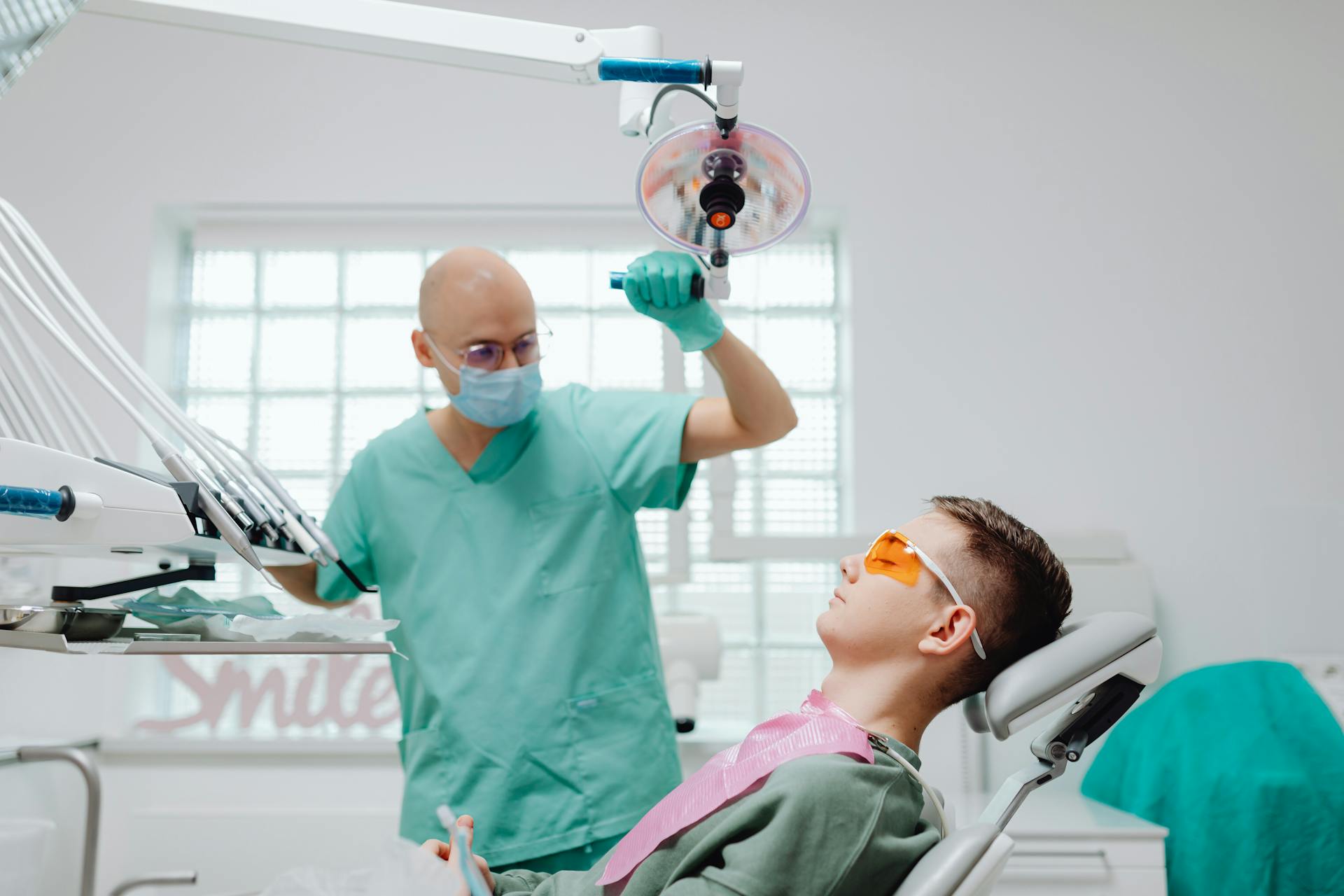
A dental cleaning may involve a full mouth exam, dental charting and probing, full mouth dental X-rays, scaling of dental plaque, polishing, and tooth removal if needed.
These procedures can be pricey, with costs ranging from $500 to $5,000 for dental cleanings, depending on the region and whether you go to a general vet or a dental specialist.
Your vet may prescribe oral antibiotics after a professional dental cleaning to prevent infections.
Here's a summary of the treatment options:
- Dental Cleaning and Dental Procedures: Professional dental cleanings performed under anesthesia to remove plaque, tartar, and bacteria from a dog's teeth and gums.
- Tooth Extraction: Extraction of severely infected or damaged teeth to prevent further complications and alleviate pain.
- Antibiotics: Prescribed to treat bacterial infections associated with oral disease.
- Pain Management: Pain medication or anti-inflammatory drugs may be prescribed to manage discomfort and inflammation.
- Oral Surgery: Surgery may be necessary to remove infected tissue or tumors and restore oral health.
Consequences and Management
If your dog has dental diseases, it can lead to serious health issues, including kidney damage, heart problems, and even death.
Dog dental diseases can be prevented with regular brushing and dental care, which should start as early as possible, ideally from 3-4 months of age.
Left untreated, dental diseases can progress to the point where your dog's teeth may need to be extracted, which can be painful and costly.
Research suggests that dogs with dental diseases are more likely to experience chronic pain, which can affect their appetite and overall quality of life.
Regular dental check-ups can help identify and manage dental diseases early on, reducing the risk of these serious complications.
Consequences of Untreated
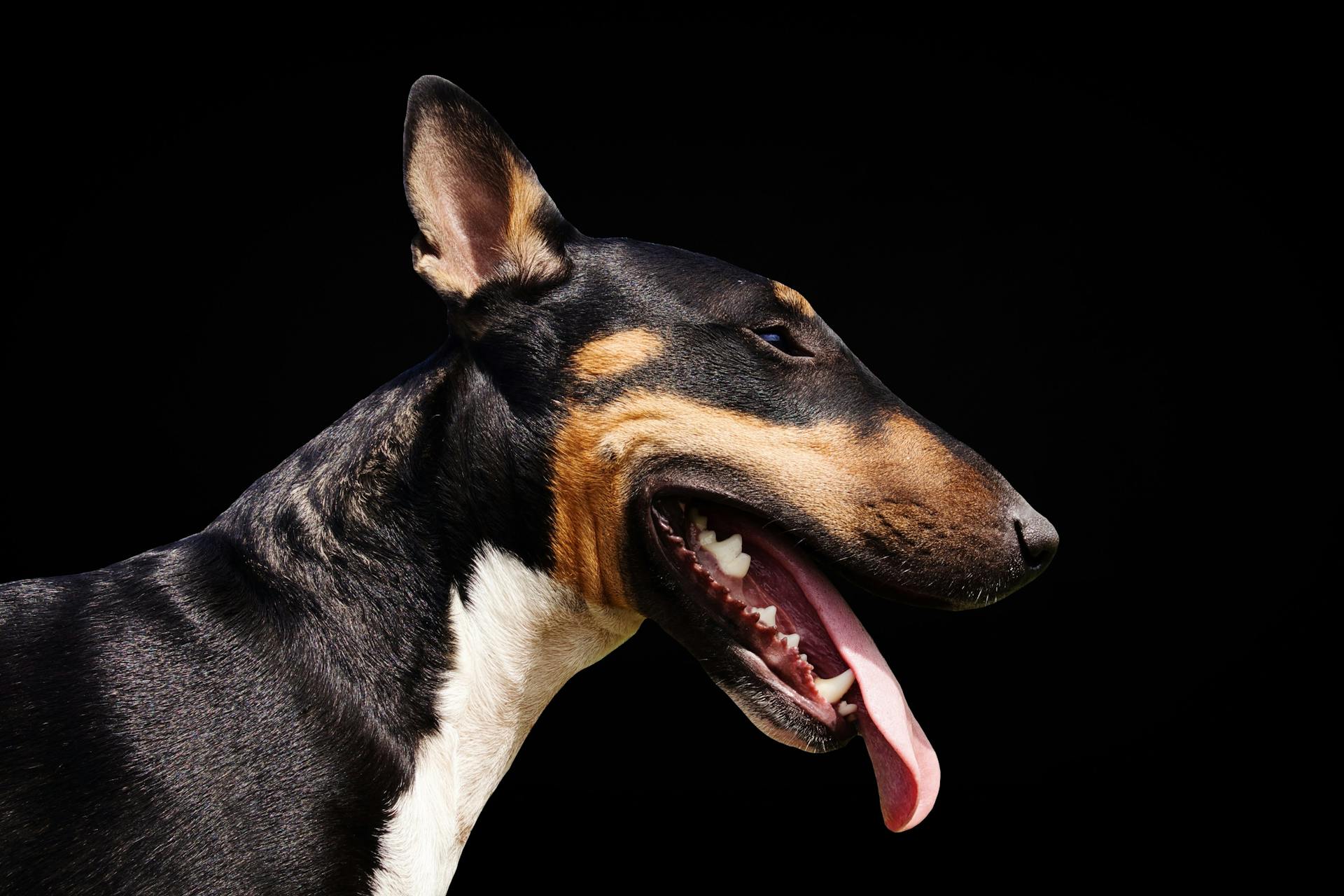
Untreated periodontal disease can have severe health implications for dogs, affecting not only their mouth but also their entire body.
If left untreated, periodontal disease can lead to eye issues. This is a serious concern because it can cause permanent damage to a dog's vision.
Jaw fractures are another possible outcome of untreated periodontal disease. This can be extremely painful for dogs and may even require surgery.
Oral cancer is a risk for dogs with untreated periodontal disease. This type of cancer can be aggressive and difficult to treat.
Tooth abscesses can also occur if periodontal disease is left untreated. These painful abscesses can be a source of discomfort for dogs and may require veterinary attention.
Oronasal fistulas can be a complication of untreated periodontal disease. This is a serious condition that can cause a hole to form between a dog's mouth and nose, leading to chronic infections.
Take a look at this: Dog Diseases That Cause Diarrhea
Recovery and Management
Recovery from periodontal disease in dogs depends on the treatment needed, with simple cleanings and scaling allowing dogs to be back to their regular selves the next day.
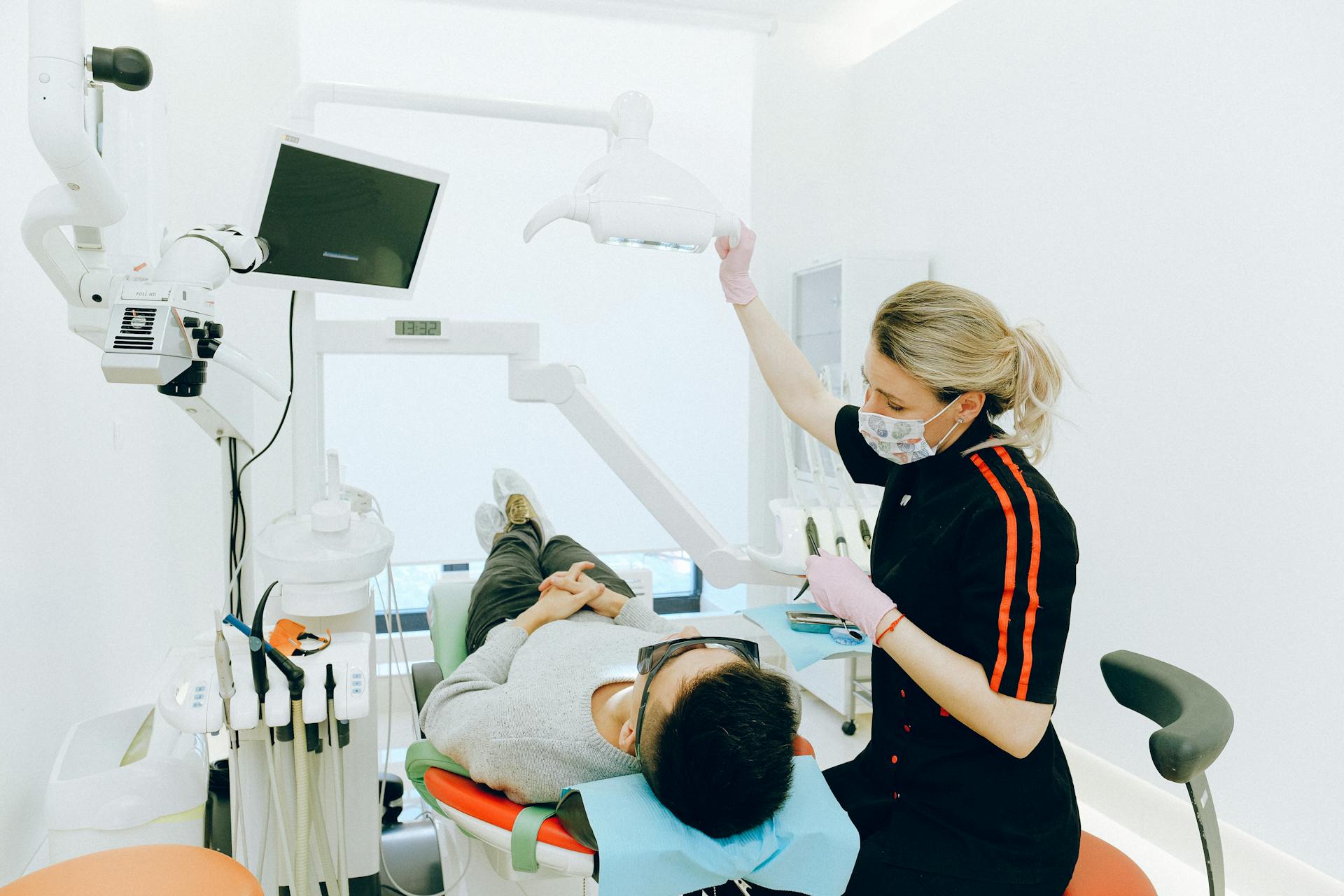
Anesthesia recovery time can vary, but in most cases, dogs are fine the day after treatment. The extraction sites themselves take about a week to heal, so dogs may be sensitive in the mouth during this time.
Dogs with periodontal disease in Stages 3 and 4 require a full commitment from their owners, including daily administration of pain and anti-inflammatory medication, as well as antibiotics to prevent infections.
Regular follow-up vet visits are crucial during these latter stages of periodontal disease, as they help ensure the dog is recovering properly and catch any potential issues early.
Special Cases and Conditions
For dogs with certain health conditions, dental disease can be a particularly big concern.
Dogs with kidney disease, for example, may be more prone to dental problems due to the buildup of tartar and plaque.
If your dog has a history of heart problems, it's especially important to keep their teeth clean to prevent bacteria from entering the bloodstream.
Canine Ameloblastoma
Canine Ameloblastoma is a type of tumor that we commonly encounter in our canine patients.
This tumor was previously known as an acanthomatous epulis, but that term is outdated and non-specific.
A pathologist has provided more accurate definitions of epulis tumors, including Canine Acanthomatous Ameloblastoma.
Canine Acanthomatous Ameloblastoma is a specific type of epulis tumor that has been studied in-depth.
Developmental Abnormalities
Developmental Abnormalities can be a challenge for dog owners. Many of these abnormalities have a genetic component.
Some developmental abnormalities affect a dog's comfort and health, requiring treatment.
Malocclusion, a type of developmental abnormality, can be skeletal or dental.
Abnormal cases of malocclusion may require extraction or surgery to create additional space or reposition the teeth.
Some breeds are more prone to developmental abnormalities, such as the Bulldog.
In general, abnormalities that only affect the look of a tooth do not require treatment.
Canine Contagion and Influence
As a dog owner, you may have noticed that your furry friend's behavior can change when they're dealing with dental issues. Acting withdrawn or aggressive is a common behavioral change in dogs with periodontal disease.
Chewing differently is another sign that your dog may be experiencing dental problems. Smacking of gums can also be a giveaway that your dog needs dental attention.
If your dog is reluctant to play with chew toys, it may be a sign that their dental health is suffering. Similarly, an unwillingness to have their teeth brushed or their lips or teeth touched can indicate that they're in pain or discomfort.
Here are some common behavioral changes to watch out for:
- Acting withdrawn or aggressive
- Chewing differently
- Smacking of gums
- Reluctance to play with chew toys
- An unwillingness to have their teeth brushed
- Being opposed to having their lips or teeth touched
Canine Contagion in Humans and Pets
Canine periodontal disease is not contagious to humans or other pets.
It's caused by an inflammatory reaction to bacteria that makes its way under the gums, and it's not something that can be passed on to others.
This means you don't have to worry about getting sick from your furry friend's dental issues.
In fact, periodontal disease is a common issue in dogs that can be prevented with regular dental care and check-ups.
Behavioral Changes Due to Canine Influence
As we explore the fascinating topic of canine influence, it's essential to understand how dogs can impact our behavior, especially when it comes to their own health.
Dogs can become withdrawn or aggressive as a result of canine periodontal disease, which affects their oral health.
Their behavior may change due to physical discomfort or pain, causing them to chew differently or smack their gums in an attempt to alleviate the discomfort.
A dog with periodontal disease may also show reluctance to play with chew toys, as the pain and discomfort make it difficult for them to enjoy activities they once loved.
Some dogs may become opposed to having their lips or teeth touched, which can make dental care a challenging task for their owners.
Here are some common behavioral changes associated with canine periodontal disease:
- Acting withdrawn or aggressive
- Chewing differently
- Smacking of gums
- Reluctance to play with chew toys
- An unwillingness to have their teeth brushed
- Being opposed to having their lips or teeth touched
Frequently Asked Questions
How long can a dog live with dental disease?
Untreated dental disease can shorten a dog's life by up to two years or more. Regular veterinary care and dental check-ups are crucial to prevent this from happening
What is Stage 4 dental disease in dogs?
Stage 4 dental disease in dogs is a severe condition characterized by pronounced infection, advanced damage, and severe pain in the mouth. If left untreated, it can lead to serious health complications and a significant decline in your dog's quality of life
Sources
- https://www.merckvetmanual.com/dog-owners/digestive-disorders-of-dogs/dental-disorders-of-dogs
- https://www.smalldoorvet.com/learning-center/medical/periodontal-disease-in-dogs/
- https://www.petsbest.com/blog/how-to-recognize-dental-disease-in-your-pet
- https://prideandgroom.com/blogs/news/dental-disease-in-dogs
- https://animaldentalspecialist.com/periodontal-disease/
Featured Images: pexels.com
